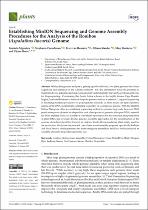| dc.contributor.author | Mgwatyu, Yamkela | |
| dc.contributor.author | Cornelissen, Stephanie | |
| dc.contributor.author | van Heusden, Peter | |
| dc.date.accessioned | 2022-09-20T09:43:31Z | |
| dc.date.available | 2022-09-20T09:43:31Z | |
| dc.date.issued | 2022 | |
| dc.identifier.citation | Mgwatyu, Y. et al. (2022). Establishing minion sequencing and genome assembly procedures for the analysis of the rooibos (aspalathus linearis) genome. Plants, 11(16), 2156. https://doi.org/10.3390/plants11162156 | en_US |
| dc.identifier.issn | 2223-7747 | |
| dc.identifier.uri | https://doi.org/10.3390/plants11162156 | |
| dc.identifier.uri | http://hdl.handle.net/10566/7926 | |
| dc.description.abstract | While plant genome analysis is gaining speed worldwide, few plant genomes have been
sequenced and analyzed on the African continent. Yet, this information holds the potential to
transform diverse industries as it unlocks medicinally and industrially relevant biosynthesis pathways
for bioprospecting. Considering that South Africa is home to the highly diverse Cape Floristic
Region, local establishment of methods for plant genome analysis is essential. Long-read sequencing
is becoming standard procedure for plant genome research, as these reads can span repetitive
regions of the DNA, substantially facilitating reassembly of a contiguous genome. With the MinION,
Oxford Nanopore offers a cost-efficient sequencing method to generate long reads; however, DNA
purification protocols must be adapted for each plant species to generate ultra-pure DNA, essential
for these analyses. | en_US |
| dc.language.iso | en | en_US |
| dc.publisher | MDPI | en_US |
| dc.subject | Rooibos | en_US |
| dc.subject | Plant genome | en_US |
| dc.subject | Biotechnology | en_US |
| dc.subject | Africa | en_US |
| dc.subject | Medicinal plants | en_US |
| dc.title | Establishing minion sequencing and genome assembly procedures for the analysis of the rooibos (aspalathus linearis) genome | en_US |
| dc.type | Article | en_US |

